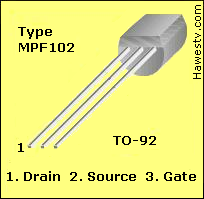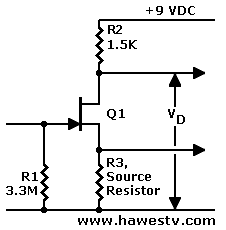Index
- Replacements for the MPF102
- Replacement Table
- Getting the Best Tone
- Finding Your Own Replacements
- What to Look For
| Tweet |
|

|
Replacements for the MPF102
No more MPF102s. My local Radio Shack store quit stocking my favorite JFETs, the MPF102 and 2N3819. Poor Radio Shack! The stores can't stock what they can't buy. Wholesale vendors don't sell the MPF102 or 2N3819 anymore. These days, neither Fairchild nor Siliconix manufactures these JFETs. Fortunately there are good alternatives, but these require a little hunting and gathering.
|
|
|
|
What should you do? Substitute! Radio Shack once sold four NTE equivalents for the MPF102. These parts were available over the Web, with free shipment to your local store. Yet since Radio Shack's 2015 reorganization, the Web site can no longer fix you up with these equivalents. I still recommend the parts, though. Fairchild offers a fifth replacement JFET, the J113. (See below). Maybe you can find one of these parts at Mouser, Fry's, Allied, NTE, or Avnet. New-old stock. You can also check eBay for available prices on a new-old stock MPF102. Some such parts come from China. Amazon now carries Chinese parts, too. (I understand that these are Chinese-manufactured parts, not new-old stock. Parts tolerances might vary quite a bit.) If the vendor is over there, standard shipping to the U.S. might take a month. I've tested two of each replacement part in the Hawes JFET preamp circuit. The replacement JFETs seem to bias up all right. Of course, I don't know how they'll sound with your guitar or microphone. I think these devices are worth a try. I recommend trying one of the less-expensive parts. The cheapest JFET is the Fairchild J113, for which Mouser will give you a wholesale price. (For JFETs by NTE, you'll pay retail.) |

Pinout for MPF102, J113, & NTE457 |
The part numbers and vendor names below are clickable. Click for links to more information.
| From Allied or NTE | From Mouser or Avnet | |||
| NTE457 | NTE 469 | NTE132 | NTE456 | J113 |
| TO-92 package. Same pinout as MPF102! | TO-92 package. Doesn't match MPF102. | Small, plastic TO-106 package. Short, stiff leads in a triangle. | Four-pin, metal TO-72 package. Expensive. | TO-92 package. Same pinout as MPF102! |
| Recommend? | ||||
| Yes! ★ ★ ★ ★ ★ | Yes, ★ ★ ★ ★ | Yes, ★ ★ ★ | No, ★ ★ | Yes! ★ ★ ★ ★ ★ |
For more MPF102 substitutes, see our parts-substitution FAQ.
Differences between parts in the table (above). For our use in a nine-volt preamp, I don't detect any important difference in the more expensive NTE parts. If these FETs are available in the corner store, the convenience might be worthwhile.
One that I don't recommend: NTE456. If you can't find the other parts, an NTE456 will work. Otherwise, it's the least attractive choice. Here are my reasons...
- Expense. The NTE 456 is the most expensive of the MPF102-equivalent JFETs. For the high price, this part doesn't deliver any added value, at least not for our audio project.
- Source Resistor. The NTE456 isn't a drop-in replacement. It might require a larger source resistor than the other devices use. In my original MPF102 circuit, I use a 560-ohm source resistor. The other replacement JFETs bias fine with this resistor. Yet the NTE456 samples that I tried seem to require something larger, perhaps 680 ohms. What does that mean? It means this: The NTE456 might develop less voltage gain than does a typical MPF102.
- Four pins. The NTE456 is a four-pin device. The four pins are: Case, drain, gate and source. The "case" pin allows you to ground the metal case of the device. In some projects, particularly RF projects, this pin provides a shield effect. If you need to shield your JFET from stray RF fields, you should ground the case pin. Otherwise, the fourth pin is just a nuisance.
Be careful! Only the NTE457 and J113 have the same pinout as the obsolete MPF102. Wire the parts according to the datasheets. Datasheets for the NTE parts and the Fairchild J113 are available online. The J113 is officially a “switching JFET.” I don't know, but it might sound a little different when you bias it for use in an analog circuit. This difference might be distinctive and desirable. Or you might not notice any difference. If you have feelings one way or the other, please drop me a line. (Contact details are at the bottom of this page.) Be particularly careful not to expose the gate pin to static or positive DC voltage. If you connect the gate to the positive supply, the FET probably won't survive. (“Why my guitar gently weeps.”)
Getting the Best Tone
Source Resistor Tweak. For best tone, a slight change to the 560-ohm source resistor might be necessary. As usual, measure the DC, no-signal drain voltage. With a fresh battery, the ideal voltage is from 4.5 to 5.72 volts. To increase the drain voltage, increase the 560-ohm resistor value (Example: 620, 680, 750, 820 ohms and so on). Here's the procedure...
|

|
To decrease the drain voltage, reduce the 560-ohm resistor value (Example: 470, 390, 330, 220 ohms and so on). If you're within the ideal voltage range, you're fine. Don't worry about perfection.
Go to Page: 1 2 Next
|
♦ WARNING. This is your project. Your achievement is entirely yours. I assume no responsibility for your success in using methods on these pages. If you fail, the same is true. I neither make nor imply any warranty. I don't guarantee the accuracy or effectiveness of these methods. Parts, skill and assembly methods vary. So will your results. Proceed at your own risk. ♦ WARNING. Electronic projects can pose hazards. Soldering irons can burn you. Chassis paint and solder are poisons. Even with battery projects, wiring mistakes can start fires. If the schematic and description on this page baffle you, this project is too advanced. Try something else. Again, damages, injuries and errors are your responsibility. — The Webmaster |
|
Copyright © 2014 by James T. Hawes. All rights reserved.
•URL: http://www.hawestv.com/amp_projects/fet_preamp/fet-mpf102-sub1.htm
|